Burger Giants Roll Out Remodels, but Are You Noticing?
The biggest fast food burger chains in the U.S. are eager to fight sluggish sales trends and the perception that they're downscale shops serving nutritionally deficient or bland fare. But the battle for a better reputation isn't just about the food.
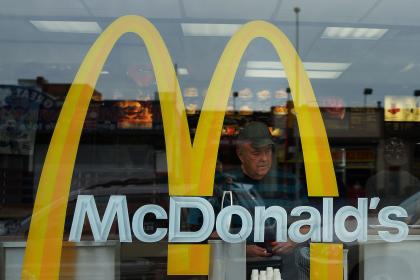
Yes, a hefty part of the bid to counter the traditional view of fast food establishments can be seen on the menus, where offerings billed as healthier, more creative or both are finding space. McDonald's (MCD) recently started selling a new chicken-based line called the McWrap, an egg white McMuffin and chicken wings as a special promotion. Burger King (BKW) put a turkey burger on sale at its stores for a limited time and tweaked its veggie burger. Wendy's (WEN) went pub-style with a pretzel-dough bun. And salads, we all know, are frequently found options at the hamburger sellers.
But store remodels, while less publicized than menu changes, also play a critical role in the industry's customer-acquisition plan. With an ever-growing number of updated exteriors and dining rooms under their banners, the burger giants are aiming to appeal to customers not just with what's on the tray but with features such as wall-mounted TVs, Wifi and lounge seating. And they could use the boost: In the second quarter, McDonald's had U.S. same-store sales growth of only 1%. For Wendy's, second-quarter comp sales at North American corporate stores increased 0.4%, and at franchised locations it was 0.3%. Burger King's U.S. and Canada same-store sales fell 0.5%.
John Gordon, principal at Pacific Management Consulting Group and a long-time analyst of the restaurant sector, says the new looks do matter to American diners.
"In the restaurant space, particularly in the United States, but really worldwide, customers judge the perceived price value of the restaurant not just about the food, but also the appearance of the store, the location of the store [and] how the employees act," he says.
Throughout the industry, remodeling is a goal, although the financial resources might not always be there. This push toward fresh visuals, when it can be done, is driven by several factors, among them the nicer chains such as Chipotle (CMG) and the fact that the competition is doing it – no one wants to be left behind.
While the cost and extent of the remodels vary by chain, quite often the bulk of the expense falls on franchise owners, who run the vast majority of McDonald's, Burger King and Wendy's locations. Regardless of who pays, redoing one store is going to cost several hundred thousand dollars, generally speaking. There does appear to be a positive result, with Wendy's saying sales at company-operated remodeled or new-style restaurants "have increased on average by more than 25 percent."
Though not a guarantee, boosting the receipts is clearly at the top of a restaurant owner's wish list when they undertake an expensive remodel. "In almost every case, not every case, though, but in many cases, there is incremental sales and profit flow-through that results from a remodel, and they wouldn't do it if that kind of incremental gain wasn't being realized," Gordon says.
Below, we look at the largest U.S. burger chains by unit count and some of what they're putting into their facelifts.
****
Wendy's tiered approach
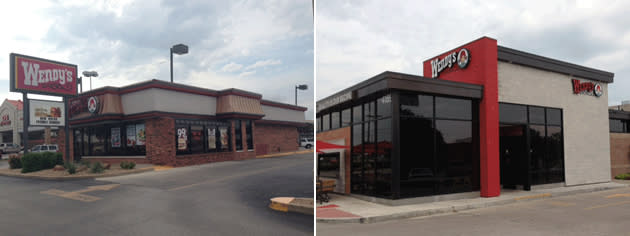
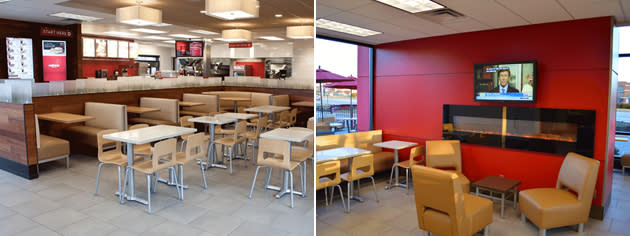
Top row: An older Wendy's (left) and a new model. Bottom row: New interior designs.
Dublin, Ohio-based Wendy's, which is in the process of lowering its company-owned store count to 15% of the total locations from 22% currently, has put the price of a remodel at $375,000 to $750,000, depending on the alterations. Because it wants franchisees to take part in its remodeling program, Wendy's is offering cash incentives of as much as $100,000 toward the reworking of an individual store.
This year Wendy's said it expects to remodel about 100 existing company-owned restaurants and to open around 25 new stores with the updated look and feel. The company, with 5,817 stores at the close of 2012, also predicts that franchisees will remodel approximately 100 restaurants and build 40 new shops this year.
Denny Lynch, senior vice president of communications at Wendy's, discussed the prototype remodels with Nation's Restaurant News, saying the company was aiming for a "more modern" approach that included new colors and textures along with a greater amount of glass on the outside.
When you visit one, don't be surprised if you find a lounge-type area with a fireplace, one where you can watch a flat-screen TV while sitting around in padded chairs. It certainly looks pricier than the old stores, and it's not unlike the feel of Chipotle and similar restaurants, with darker colors more prominent, new flooring and wood features.
If you want to linger during and after your meal, you'll probably like the new Wendy's. Of the three top hamburger sellers, its stores are arguably the biggest departure from the previous style.
****
Bricks for the Whopper buyer
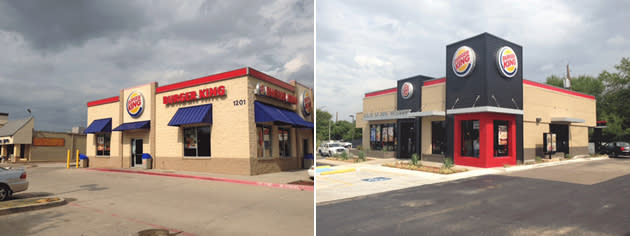
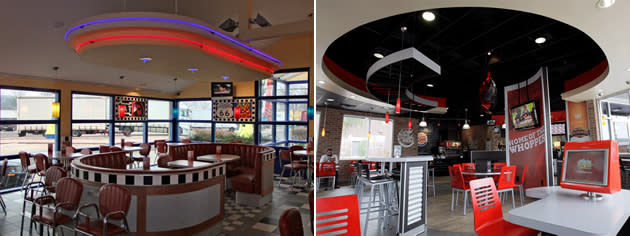
Top row: An older-style restaurant (left) and a new design. Bottom row: An updated interior, 2011 (left), and a new design photographed in 2009.
Burger King, which had 7,183 U.S. restaurants at the end of last year, wants to have 40% of its stores in the United States and Canada with its new design by 2015. The updated model, the Miami-based company says, "draws inspiration from our signature flame-grilled cooking process and incorporates a variety of innovative elements to a backdrop that evokes the industrial look of corrugated metal, brick, wood and concrete."
The makeover isn't quite as ambitious as it was initially, when a remodel was $500,000 to $600,000 (for instance, the right-side interior image above is from an original design in 2009). However, the retooled stores have kept some of the original interior elements the company envisioned, even as the cost has been lowered to about $300,000. By the end of last year, 19% of Burger King's U.S. and Canadian restaurants had been upgraded. The new-look stores have seen sales increase an average of 10% to 15% each, the company says.
As part of its plan to get franchisees – who account for 97% of the Burger King system – on board, incentives have been offered, including lower up-front franchise fees and temporary cuts in royalty payments to the corporation.
When you walk into a new store, you'll notice marked differences immediately from the long-standing Burger Kings. The stools and lighting in some units make the dining areas more like a bar section you might find at an Applebee's or Chili's. If you appreciate wood, brick and metal inside rooms, you'll like the look. It's much more modern, though the darker colors can be somewhat club-like. That may be good or bad, depending on your perspective.
****
Modernization for Ronald & Co.
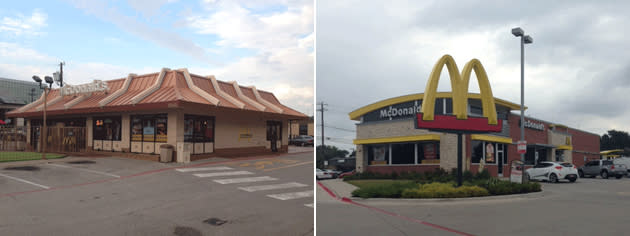
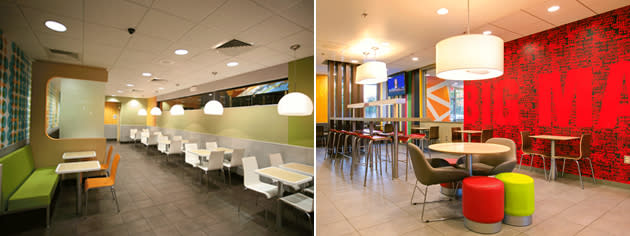
Top row: An older restaurant (left) and a remodeled design. Bottom row: Updated interiors.
At McDonald's, more than 1,600 locations around the world are probably going to be remodeled in 2013 as part of an ongoing program for the Oak Brook, Ill., company. Chief Financial Officer Peter Bensen noted on a conference call in July that, because of the extensive work already done, nearly half of McDonald's U.S. stores will have been updated by the end of the year.
The U.S. was home to 14,157 McDonald's restaurants as of Dec. 31, about 41% of its worldwide total. Of the domestic stores, 89% are operated by franchisees. System-wide globally, some 2,400 stores were remodeled last year, while another 1,400 were new openings.
On average, it now requires in the area of $600,000 for remodeling a McDonald's location, according to Bloomberg.
While the interiors unquestionably are contemporary and updated, the changes aren't always overly dramatic. Blues, greens and yellows can be found in some stores vs. the deep red, black and brown that are prominent at new Wendy's and Burger King units. Of the three, McDonald's is probably the least radical interior remodel, and if you want a brighter room all-around, this may be the more likely place to find it.
Then again, if you're going to miss the "fedora" rooftops, the McDonald's redesigns might not be for you.
Let us know what you think of the new stores, especially if you've seen them in person. Do the remodels make you more likely to eat at McDonald's, Wendy's or Burger King than you were at an old-style location?

